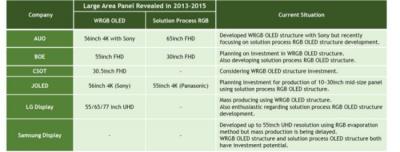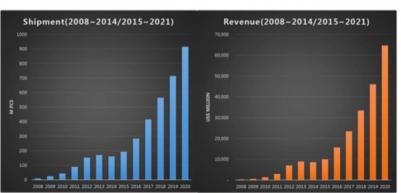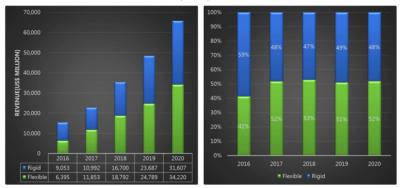During the OLED World Summit, an analyst from UBI gave an interesting presentation, showing the company's view of the current status of the OLED TV industry, and their OLED market forecasts for upcoming years.

So first of all, we have LG and Samsung. LGD has obviously been successful in launching WOLED OLED TVs, and scaling up to mass production has been achieved. LG is also hopeful that solution processing will enable them to produce RGB-structured OLEDs efficiently. LG is collaborating with Merck and Espon on printing technologies.
Samsung has developed evaporation based RGB OLEDs, but did not manage to scale this up to mass production. SDC is still looking at evaporation, solution processing and a WOLED-based architecture as possible routes to OLED TV production. For a solution-based solution, Samsung is cooperating with Kateeva (that is collaborating with DuPont and Sumitomo).
Japan's Sony and Panasonic produced OLED TV prototypes, using an WRGB architecture (Sony) and a solution-based RGB architecture (Panasonic). The two companies scrapped their OLED TV production plans - and later spun off the OLED business units to JDI which later spun it off to JOLED. JOLED is hopeful that solution-based RGB OLEDs will be a succesful route to OLED TV production. JOLED is collaborating with Sumitomo and Epson.
AUO has been collaboration with Sony on a WOLED-base OLED TVs, but is currently focusing on soltuion-processing development. China' BOE is planning to produce WRGB-based OLED TVs, but is also developing a solution-based process. Finally UBI says that CSoT is also considering a WRGB OLED TV. CSoT's parent company, TCL, is also partnering with Kateeva and recently ordered a 200x200 mm R&D ink jet printing system.
As you can see, while WRGB has been successful at this stage, all OLED producers, including LGD, considers it a temporary solution - and most companies believe that a printing-based process of solution-based OLEDs will eventually be adopted. According to UBI, the utilization of material in a solution-based process will reach 70% to 85% - much higher than the 30% achieved in VTE. In addition, the emitting layers can be thinner by around 20% in a solution-based system - I am not sure why.

UBI also detailed their market forecasts. By 2020, the AMOLED market will reach around $65 billion and over 900 million panels. UBI is very bullish on the OLED market, especially the flexible OLED market will will amount for more than 50% of the total OLED market starting in 2016 or 2017 (!).


